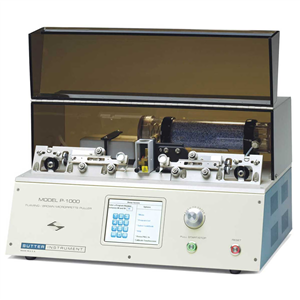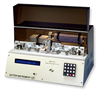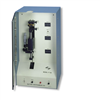

P-1000
Next Generation Micropipette Puller from Sutter
- Overview
- Specifications
- Accessories
- Citations
- Related Products
Overview

There are 1 images available to view - click to enlarge and scroll through the product gallery.
P-1000 DataSheet
/ Download as PDF
P-1000 DataSheet - French
/ Download as PDF
P-1000 Instruction Manual
/ Download as PDF
Pipette Cookbook
/ Download as PDF
Comparison P-1000 P-97
/ Download as PDF
- Colour touch-screen interface
- Safe heat mode to protect and extend filament life
- Pipette Cookbook program directory
- Pre-heat mode improves stability
- Line repeat mode simplifies multi-line programming
- Help topics and error detection
- Glossary with micropipette and puller terminology
- Copy & Paste function for writing new programs
- Jaw temperature sensor helps define ideal pulling conditions
- Record of last two pull results
- Ramp test more easily accessed and can now be stored and referenced within each program. Helps to establish program heat settings and protect filament.
- Two symmetrical pipettes with each pull
- Self-contained air supply with filtration system and humidity control chamber
- Memory storage for up to 100 programs
- Two cooling modes: time and delay
Developed through years of experience with the Flaming/Brown style micropipette pullers and infused with leading edge technology, Sutter is proud to introduce the P-1000 micropipette puller. The most obvious new feature is the color touchscreen display that provides an intuitive and full-featured interface.
The extensive library of programs found in the popular Sutter Cookbook has been incorporated into the P-1000 puller and is available to the user via the touchscreen display. You need only specify the glass, filament, and type of pipette you require and a suitable program will be identified and available for installation. This takes the guesswork out of pipette pulling and simplifies programming.
The pre-heat mode actively heats and controls the jaw temperature and assures that the jaws have reached a specific temperature before the glass is pulled. This can increase the stability of the program from pull to pull.
Copy and paste functions ensure that programs can be easily written and the line repeat mode simplifies multi-line programming.
A safe heat mode is an additional feature that helps the user avoid using heat settings that might damage or burn out the filament. When the safe heat mode is turned on, the puller will “check” the installed heat and alert the user when a given heat value is too low or too high in relation to the ramp value. User notes can be added to each program for annotating important information.
New features for the P-1000 include: diagnostic testing of all puller components, built-in error detection of air pressure loss or filament burnout, easy access to ramp test, measurement of jaw temperature, and access to previous pull results with the heat on times for each cycle of the program. Help topics are pre-loaded to assist with on-site troubleshooting and the built-in glossary includes text, pictures, and diagrams explaining the terms used in micropipette fabrication. A rotary dial is offered as an alternative to the keypad for numerical entry.
Troubleshooting Pipette Variability
Recording of Webinar, May 2016
Specifications
| Dimensions | 21in x 14in x 12in 53cm x 36cm x 30cm |
| Weight | 41lbs 18.59kg |
| Electrical | 115/230 Volts 50/60 Hertz power line |
| RoHS Compliant |
Accessories
Citations
Amarasinghe, P., & Abelev, A. (2015). Micromechanical Determination of the Tensile Strength of Flocculated Artificial Marine Cohesive Sediment. Mechanics Research …. Retrieved from https://www.sciencedirect.com/science/article/pii/S0093641315000038
Chaurasia, A., & Sajjadi, S. (2015). Millimetric core–shell drops via buoyancy assisted non-confined microfluidics. Chemical Engineering Science. Retrieved from https://www.sciencedirect.com/science/article/pii/S0009250915001438
Han, Z., Jiang, Y., Yang, Y., Li, X., Yang, Z., Cao, K., & Wang, D. (2015). Deletion of PDK1 Causes Cardiac Sodium Current Reduction in Mice. PloS One. Retrieved from https://dx.plos.org/10.1371/journal.pone.0122436
He, M., Xue, Z., Zhang, Y., Huang, Z., & Fang, X. (2015). Development and Characterizations of A Miniature Capillary Electrophoresis Mass Spectrometry System. Analytical …. Retrieved from https://pubs.acs.org/doi/abs/10.1021/ac504868w
Koganti, S., Zhu, Z., Subbotina, E., & Gao, Z. (2015). Disruption of KATP Channel Expression in Skeletal Muscle by Targeted Oligonucleotide Delivery Promotes Activity-linked Thermogenesis. Molecular …. Retrieved from https://www.nature.com/mt/journal/v23/n4/abs/mt201521a.html
Ladas, T., & Chiang, C. (2015). Seizure reduction through interneuron-mediated entrainment using low frequency optical stimulation. Experimental …. Retrieved from https://www.sciencedirect.com/science/article/pii/S0014488615001077
Lee, W., Wahman, D., & Pressman, J. (2015). Monochloramine-sensitive amperometric microelectrode: optimization of gold, platinum, and carbon fiber sensing materials for removal of dissolved oxygen. Ionics. Retrieved from https://link.springer.com/article/10.1007/s11581-015-1454-7
Pfister, P., Rogers, M., & Parris, K. (2015). METHODS OF IDENTIFYING, ISOLATING AND USING ODORANT AND AROMA RECEPTORS. US Patent 20,150,005,177. Retrieved from https://www.freepatentsonline.com/y2015/0005177.html
Smolina, N., & Kostareva, A. (2015). Primary Murine Myotubes as a Model for Investigating Muscular Dystrophy. BioMed Research …. Retrieved from https://downloads.hindawi.com/journals/bmri/aa/594751.pdf
Wei, Y., Bian, C., Ouyang, Z., & Xu, W. (2015). A pulsed pinhole atmospheric pressure interface for simplified mass spectrometry instrumentation with enhanced sensitivity. Rapid Communications in …. Retrieved from https://onlinelibrary.wiley.com/doi/10.1002/rcm.7140/pdf
Yeo, S., Tu, F., Kim, S., Yi, G., Yoo, P., & Lee, D. (2015). Angle-and strain-independent coloured free-standing films incorporating non-spherical colloidal photonic crystals. Soft Matter. Retrieved from https://pubs.rsc.org/en/content/articlehtml/2015/sm/c4sm02482f
Zhang, Z., Sun, L., Zhu, G., Yan, X., & Dovichi, N. (2015). Integrated strong cation-exchange hybrid monolith coupled with capillary zone electrophoresis and simultaneous dynamic pH junction for large-volume proteomic. Talanta. Retrieved from https://www.sciencedirect.com/science/article/pii/S0039914015000685
Zhang, Z., Yan, X., Sun, L., Zhu, G., & Dovichi, N. (2015). Detachable Strong Cation Exchange Monolith, Integrated with Capillary Zone Electrophoresis and Coupled with pH Gradient Elution, Produces Improved Sensitivity. Analytical Chemistry. Retrieved from https://pubs.acs.org/doi/abs/10.1021/acs.analchem.5b00789
Zhao, Y., Riley, N., Sun, L., & Hebert, A. (2015). Coupling Capillary Zone Electrophoresis with Electron Transfer Dissociation and Activated Ion Electron Transfer Dissociation for Top-Down Proteomics. Analytical …. Retrieved from https://pubs.acs.org/doi/abs/10.1021/acs.analchem.5b00883


















Request
Catalogue
Chat
Print